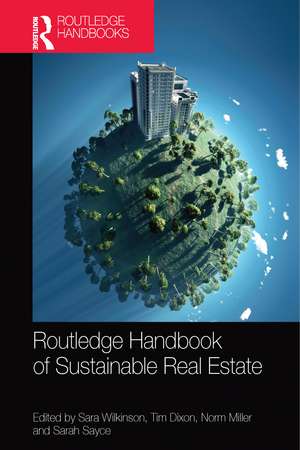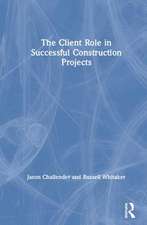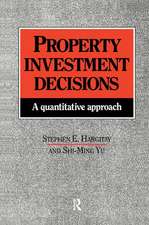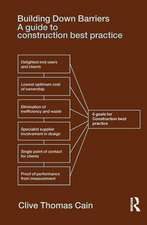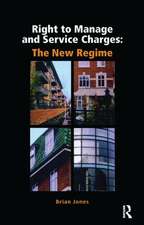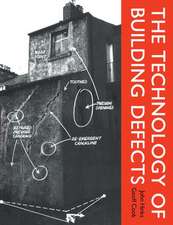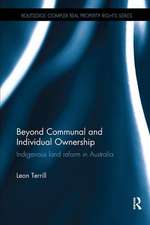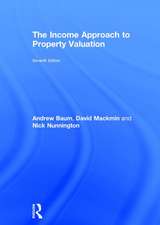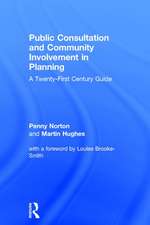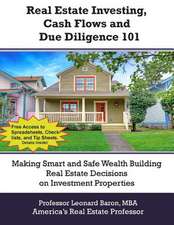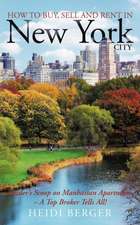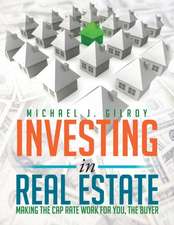Routledge Handbook of Sustainable Real Estate
Editat de Sara Wilkinson, Tim Dixon, Norm Miller, Sarah Sayceen Limba Engleză Paperback – 30 iun 2021
- governance and policy
- valuation, investment and finance
- management
- redevelopment and adaptation.
Covering all land uses from residential to commercial, retail and industrial, the Routledge Handbook of Sustainable Real Estate is an exciting mixture of received wisdom and emerging ideas and approaches from both the developed and developing world. Academics, upper-level students and researchers will find this book an essential guide to the very best of sustainable real estate research.
| Toate formatele și edițiile | Preț | Express |
|---|---|---|
| Paperback (1) | 447.72 lei 6-8 săpt. | |
| CRC Press – 30 iun 2021 | 447.72 lei 6-8 săpt. | |
| Hardback (1) | 1023.46 lei 6-8 săpt. | |
| CRC Press – 7 mar 2018 | 1023.46 lei 6-8 săpt. |
Preț: 447.72 lei
Nou
Puncte Express: 672
Preț estimativ în valută:
85.68€ • 90.09$ • 70.79£
85.68€ • 90.09$ • 70.79£
Carte tipărită la comandă
Livrare economică 17 aprilie-01 mai
Preluare comenzi: 021 569.72.76
Specificații
ISBN-13: 9781032095714
ISBN-10: 1032095717
Pagini: 446
Dimensiuni: 174 x 246 x 23 mm
Greutate: 0.73 kg
Ediția:1
Editura: CRC Press
Colecția Routledge
Locul publicării:Boca Raton, United States
ISBN-10: 1032095717
Pagini: 446
Dimensiuni: 174 x 246 x 23 mm
Greutate: 0.73 kg
Ediția:1
Editura: CRC Press
Colecția Routledge
Locul publicării:Boca Raton, United States
Public țintă
Postgraduate and UndergraduateCuprins
Editor biographies
Contributor biographies
Foreword by Theddi Wright Chappell
Acknowledgements
Part 1 Governance and policy
Chapter 1 Sustainable real estate: a snapshot of where we are
Sara Wilkinson, Norm Miller, Tim Dixon and Sarah Sayce
Chapter 2 Sustainable real estate and corporate responsibility
Norm Miller and Dave Pogue
Chapter 3 Energy upgrades in commercial property: Minimum energy efficiency standards, compliance pathways, and leases in the UK
Julia Patrick, Susan Bright, and Kathryn B. Janda
Chapter 4 Voluntary programs for low-carbon building development and transformation: Lessons from the United States
Jeroen van den Heijden
Chapter 5 Sustainable office retrofit in Melbourne
Sara Wilkinson
Chapter 6 International standards: Key to unlocking the value of green buildings?
Ben Elder
Part 2 Valuation, investment and finance
Chapter 7 Valuing sustainability in commercial property in Australia
Georgia Warren-Myers
Chapter 8 Existing building retrofits: Economic payoff.
Norm Miller and Nils Kok
Chapter 9 Building sustainability into valuation and worth
Sarah Sayce
Chapter 10 Green REITS
David Parker
Chapter 11 US green REITS
Vivek Sah and Norm Miller
Chapter 12 The ‘green value’ proposition in real estate: A meta-analysis
Ben Dalton and Dr Franz Fuerst
Chapter 13 Sustainability and housing value in Victoria, Australia
Neville Hurst and Sara Wilkinson
Part 3 Management
Chapter 14 Corporate real estate management: The missing link in sustainable real estate
Christopher Heywood
Chapter 15 The burgeoning influence of sustainability in managing UK retail property
Jessica Ferm and Nicola Livingstone
Chapter 16 Sustainable facilities management
Paul Appleby
Chapter 17 Building Energy Efficiency Certificates and commercial property: The Australian experience
Clive Warren
Chapter 18 Workplace ecology
Craig Langston and Abdallah Al-khawaja
Chapter 19 Creating a green index based on tenant demand for sustainable office buildings and features
Spenser J. Robinson and Robert A. Simons
Part 4 Redevelopment and adaptation
Chapter 20 Multi-stakeholder partnership promotes sustainable housing supply chain
Connie Susilawati
Chapter 21 Scaling up commercial property energy retrofitting: What needs to be done?
Tim Dixon
Chapter 22 Sustainable building conversion and issues relating to durability
Hilde Remøy and Peter de Jong
Chapter 23 Sustainable urban redevelopment in the Netherlands
Erwin Huerkens
Chapter 24 Smart growth and real estate development in Saudi Arabia
Abdullah Alhamoudi and Peter Lee.
Chapter 25 Applying sustainability in practice: An example of new urban development in Sweden
Agnieszka Zalejska-Jonsson
Cha
Contributor biographies
Foreword by Theddi Wright Chappell
Acknowledgements
Part 1 Governance and policy
Chapter 1 Sustainable real estate: a snapshot of where we are
Sara Wilkinson, Norm Miller, Tim Dixon and Sarah Sayce
Chapter 2 Sustainable real estate and corporate responsibility
Norm Miller and Dave Pogue
Chapter 3 Energy upgrades in commercial property: Minimum energy efficiency standards, compliance pathways, and leases in the UK
Julia Patrick, Susan Bright, and Kathryn B. Janda
Chapter 4 Voluntary programs for low-carbon building development and transformation: Lessons from the United States
Jeroen van den Heijden
Chapter 5 Sustainable office retrofit in Melbourne
Sara Wilkinson
Chapter 6 International standards: Key to unlocking the value of green buildings?
Ben Elder
Part 2 Valuation, investment and finance
Chapter 7 Valuing sustainability in commercial property in Australia
Georgia Warren-Myers
Chapter 8 Existing building retrofits: Economic payoff.
Norm Miller and Nils Kok
Chapter 9 Building sustainability into valuation and worth
Sarah Sayce
Chapter 10 Green REITS
David Parker
Chapter 11 US green REITS
Vivek Sah and Norm Miller
Chapter 12 The ‘green value’ proposition in real estate: A meta-analysis
Ben Dalton and Dr Franz Fuerst
Chapter 13 Sustainability and housing value in Victoria, Australia
Neville Hurst and Sara Wilkinson
Part 3 Management
Chapter 14 Corporate real estate management: The missing link in sustainable real estate
Christopher Heywood
Chapter 15 The burgeoning influence of sustainability in managing UK retail property
Jessica Ferm and Nicola Livingstone
Chapter 16 Sustainable facilities management
Paul Appleby
Chapter 17 Building Energy Efficiency Certificates and commercial property: The Australian experience
Clive Warren
Chapter 18 Workplace ecology
Craig Langston and Abdallah Al-khawaja
Chapter 19 Creating a green index based on tenant demand for sustainable office buildings and features
Spenser J. Robinson and Robert A. Simons
Part 4 Redevelopment and adaptation
Chapter 20 Multi-stakeholder partnership promotes sustainable housing supply chain
Connie Susilawati
Chapter 21 Scaling up commercial property energy retrofitting: What needs to be done?
Tim Dixon
Chapter 22 Sustainable building conversion and issues relating to durability
Hilde Remøy and Peter de Jong
Chapter 23 Sustainable urban redevelopment in the Netherlands
Erwin Huerkens
Chapter 24 Smart growth and real estate development in Saudi Arabia
Abdullah Alhamoudi and Peter Lee.
Chapter 25 Applying sustainability in practice: An example of new urban development in Sweden
Agnieszka Zalejska-Jonsson
Cha
Notă biografică
Sara Wilkinson, Tim Dixon, Norm Miller, Sarah Sayce
Recenzii
"A critical book for all corporate property and mass market housing developers. The chapters show that there are real pockets of deeper innovation and embedded sustainability practice in the market. Niches being developed that will help these companies to have a market advantage as the implications of future climate change and other ecological challenges reach consumer awareness." - Dominique Hes, Director, Thrive research hub
"For those involved in real estate either as a user, provider or consultant there can be no doubt that sustainability is a key challenge that simply cannot be ignored. The Handbook of Sustainable Real Estate brings together the work of highly experienced practitioners who, through their dedicated research and passion for the subject, provide a valuable and informed commentary upon many of the difficult issues that face us in our day-to-day activities. With sections on Governance, Valuation and Investment, Management and Redevelopment the book provides a well-balanced font of knowledge that will help students, decision and policy makers alike. I commend the handbook to those that embrace sustainability in all its forms and also to those who are yet to be persuaded." - Trevor Rushton FRICS FCABE ACI Arb, Technical Director, Watts Group Limited
"The Handbook of Sustainable Real Estate provides fascinating insights into the fundamental changes needed to ensure that property makes a substantive contribution to a sustainable future. The book employs a mix of detailed analyses and synoptic reflection to demonstrate the interlinked nature of the economic, social, cultural, organisational, technical and governance influences upon the emergence of a genuinely sustainable built environment. Drawing on international experience and expertise, it highlights the challenges of establishing agreed definitions and measures of sustainable buildings and their features, of incorporating these into real estate policy and practice, and of ensuring that their application produces robust evidence of sustainable buildings’ performance. Ways must be found for all real estate actors – developers, investors, occupiers and professional intermediaries such as appraisers – to engage with this process, even though may have ostensibly differing interests. The book shows that a promising start has been made to this process, but that much more needs to be done." - John Henneberry, Professor of Property Development, University of Sheffield, UK
"Working in sustainable real estate, one quickly comes to recognise that it is about a dynamic and active system where the sum, ‘Place making’, is far bigger than the parts, ‘Buildings’. As said Sir Patrick Geddes said "A city is more than a place in space, it is a drama in time". Sustainable place making is both integral to and drives how we live and work and enjoy the locations we inhabit. It also offers solutions for many societal and systemic problems faced by our societies today, from climate to health and well-being. The handbook is a comprehensive guide that challenges our understanding of why, how and what sustainable place making and green buildings can and should contribute to the drama of our life." - Tatiana Bosteels, Head of Responsible Property Investment, Hermes Investment Management
"Must be the most comprehensive collection of research and informed opinion to date on sustainable real estate. Reflecting the international dimension and reinforcing the argument that there are no borders regarding climate change, the editors of the handbook have brought together chapter contributions from leading researchers in sustainability in the built environment. Developed around key themes of governance and policy; valuation, investment and finance; management; and redevelopment and adaption issues the handbook stresses current deficiencies and deficits in issues central to the real estate sector stressing while technology and innovation have created new business landscapes, the professional real estate sector needs to upskill and provide leadership in creating a sustainable built environment. One of the most significant challenges identified in many of the individual chapters is the need to retrofit the existing building stock both commercial and residential property. A key message from the handbook is the need for sustained activity from public sector policy makers, building owners, professional surveyors and the financial sector in developing products and delivery vehicles to achieve energy efficiency targets and make the sector investable." - Professor Stanley McGreal, Director of the Built Environment Research Institute, Ulster University, UK
"For those involved in real estate either as a user, provider or consultant there can be no doubt that sustainability is a key challenge that simply cannot be ignored. The Handbook of Sustainable Real Estate brings together the work of highly experienced practitioners who, through their dedicated research and passion for the subject, provide a valuable and informed commentary upon many of the difficult issues that face us in our day-to-day activities. With sections on Governance, Valuation and Investment, Management and Redevelopment the book provides a well-balanced font of knowledge that will help students, decision and policy makers alike. I commend the handbook to those that embrace sustainability in all its forms and also to those who are yet to be persuaded." - Trevor Rushton FRICS FCABE ACI Arb, Technical Director, Watts Group Limited
"The Handbook of Sustainable Real Estate provides fascinating insights into the fundamental changes needed to ensure that property makes a substantive contribution to a sustainable future. The book employs a mix of detailed analyses and synoptic reflection to demonstrate the interlinked nature of the economic, social, cultural, organisational, technical and governance influences upon the emergence of a genuinely sustainable built environment. Drawing on international experience and expertise, it highlights the challenges of establishing agreed definitions and measures of sustainable buildings and their features, of incorporating these into real estate policy and practice, and of ensuring that their application produces robust evidence of sustainable buildings’ performance. Ways must be found for all real estate actors – developers, investors, occupiers and professional intermediaries such as appraisers – to engage with this process, even though may have ostensibly differing interests. The book shows that a promising start has been made to this process, but that much more needs to be done." - John Henneberry, Professor of Property Development, University of Sheffield, UK
"Working in sustainable real estate, one quickly comes to recognise that it is about a dynamic and active system where the sum, ‘Place making’, is far bigger than the parts, ‘Buildings’. As said Sir Patrick Geddes said "A city is more than a place in space, it is a drama in time". Sustainable place making is both integral to and drives how we live and work and enjoy the locations we inhabit. It also offers solutions for many societal and systemic problems faced by our societies today, from climate to health and well-being. The handbook is a comprehensive guide that challenges our understanding of why, how and what sustainable place making and green buildings can and should contribute to the drama of our life." - Tatiana Bosteels, Head of Responsible Property Investment, Hermes Investment Management
"Must be the most comprehensive collection of research and informed opinion to date on sustainable real estate. Reflecting the international dimension and reinforcing the argument that there are no borders regarding climate change, the editors of the handbook have brought together chapter contributions from leading researchers in sustainability in the built environment. Developed around key themes of governance and policy; valuation, investment and finance; management; and redevelopment and adaption issues the handbook stresses current deficiencies and deficits in issues central to the real estate sector stressing while technology and innovation have created new business landscapes, the professional real estate sector needs to upskill and provide leadership in creating a sustainable built environment. One of the most significant challenges identified in many of the individual chapters is the need to retrofit the existing building stock both commercial and residential property. A key message from the handbook is the need for sustained activity from public sector policy makers, building owners, professional surveyors and the financial sector in developing products and delivery vehicles to achieve energy efficiency targets and make the sector investable." - Professor Stanley McGreal, Director of the Built Environment Research Institute, Ulster University, UK
Descriere
With the built environment contributing almost half of global greenhouse emissions, there is a pressing need for the property and real estate discipline to investigate sustainability concerns. The Routledge Handbook of Sustainable Real Estate brings together the latest research of leading academics globally, demonstrating the nature and
